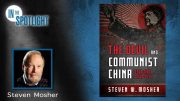The Tea Party Goes to Washington, by Rand Paul (with Jack Hunter), Center Street/Hachette Book Group: New York, NY, 2011, 254 pages, hardbound. (Available at Amazon.com.)
Freshman Kentucky Senator and medical doctor Rand Paul has written what should — and may indeed — become the new handbook of the Tea Party movement. Written by the Tea Party’s most prominent member who won its most celebrated electoral victory, The Tea Party Goes to Washington is a study of the Tea Party movement yesterday and today. It also provides a prescription from the ophthalmologist/senator for curing the nation’s fiscal ills.
It’s rare that a reviewer opens up a book with the intent of highlighting only the most important quotes in the book, and ends up highlighting almost every line. This is one of those rare books. The author describes the Tea Party movement as a decentralized movement without a single leader, but with the brilliant ideas and legislative agenda presented in this book, Rand Paul establishes himself as the Tea Party’s most prominent adherent. The book is also an ideal handbook for describing the kind of smears that will take place against people who stand up for fiscal sanity and question the status quo.
Tea Party Today: Decentralized
Rand Paul calls the Tea Party an “open mic night,” noting that “although they come together, they never really come together too much.” Paul explains that “To this day, statewide communication between the different Tea Parties in each city is spotty at best, and yet in city after city thousands of folks gather at local events. This has been the dynamic of the movement nationwide.” In some sense, the Tea Party presaged the decentralized Tunisian and Egyptian student revolutions against tyranny that relied upon social networking websites for organization. Tea Party rallies can be contrasted with the union rallies that have taken place in Wisconsin recently, in that all of the Tea Party attendees are volunteers, and are not looking to take a salary away from their rallies. And they don’t take orders from union (or any other kind of) bosses. “Despite accusations to the contrary, the Tea Party is organized from the bottom up, decentralized and independent,” Paul stresses. “No matter how much the establishment would love to control and manipulate this movement, its political narrative is dictated by the grass roots, not the other way around.”
That’s not for lack of trying, however. “There’s no question that some in the political establishment have tried to latch on to the Tea Party or manipulate the movement for their own benefit,” Dr. Paul notes. “Any Tea Partier could tell you this, and they all are aware of it precisely because maintaining their independence is so important.”
Moreover, the movement cannot be compared to the “independent” Ross Perot movement in 1996. Dr. Paul explains that “the difference is the Perot movement actually took votes from Republicans and the Tea Party brings more votes.” Witness the 2010 election results and contrast them with the disastrous election results when the neoconservative establishment ran the GOP in 2006 and 2008. “Republicans have been promising limited government for years and have delivered nothing. Conservatives simply don’t believe the Republican establishment anymore and support the Tea Party precisely because it is both outside of and in opposition to both major parties — not simply an auxiliary of the GOP.” In political parlance, the Republican National Committee found conservative votes “non-transferable” to its socialist lite-brand candidates through two consecutive congressional election cycles.
Tea Party Founding Father
“I had been Tea Party before Tea Party was cool,” Dr. Paul quips, adding “I suppose it’s symbolic that I would have spoken at what some consider the first modern Tea Party in Boston in 2007, and even more appropriate that it was in support of the man whose presidential campaign many consider a precursor to today’s Tea Party.” Rand Paul had been involved in the presidential campaign of his father — Representative Ron Paul — which served as a rallying cry against out-of-control spending that led to the Tea Party. “Dad wouldn’t get the nomination but he would do something no other presidential candidate would — create a ‘Ron Paul Revolution’ that would help form and inspire the Tea Party, break fundraising records, influence a new generation of conservatives, take Dad’s popularity to new heights– and help fund my campaign. Sure, John McCain won the nomination in 2008 — but alas, there was no ‘John McCain Revolution.'” And McCain has all but faded to obscurity. While Rep. Paul has achieved national notoriety, McCain is best known among the under 50 crowd as the “wrinkly white-haired guy” in the phony Paris Hilton mock ad during the 2008 campaign.
Despite the Ron Paul genesis of the Tea Party movement, Rand is quick to note that “the movement has certainly grown beyond just Ron Paul adherents.” The gel of the Tea movement is the move to stop federal deficit spending, the younger Paul stresses. “The ‘tea’ in Tea Party is often said to stand for ‘taxed enough already’ and, while the Tea Partiers in each city tended to be social conservatives for a strong national defense, unquestionably their primary motivation was driven by a sincere concern over the size and scope of the national debt.”
Tea Party Journey to Washington
Rand Paul’s journey to the U.S. Senate involved two nasty battles that involved his opponents lying about him, first by the Republican establishment and after the primary by the leftist national media. But despite the massive mobilization of establishment leaders in both parties against him, Paul had the Tea Party and his father’s supporters backing him. After the primary came one of the nastiest smears of Paul, where he was accused of being a closet racist for having qualms about government regulating private businesses under the 1964 Civil Rights Act. In a discussion at a local newspaper, a reporter challenged his view of the law, stressing that “‘it’s different with race, because much of the discrimination based on race was codified into law.’ I agreed with him and ended the discussion by saying, ‘Exactly, it was institutionalized. And that’s why we had to end all institutional racism, and I’m completely in favor of that.'” Of course, the liberals at the newspaper roundtable were unable to fathom that it was 100 years of racist state and local government mandates that created segregated private lunch counters, and not the other way around.
But the leftist national media didn’t even care to understand what Dr. Paul saw as an “adult conversation.” Instead, the leftist media saw an opportunity to draw political blood, and Dr. Paul was booked on MSNBC’s Rachel Maddow show. The book highlights his wife Kelley’s wisdom. Kelley sagely advised Dr. Paul: “Cancel Rachel Maddow, it’s a set-up.” But Rand wouldn’t hear it, writing “even America’s most left-wing announcer couldn’t stop me. I was invincible.” The interview proceeded as Kelley predicted. As the overly-tired Paul nevertheless reasoned like an adult, he was trashed on a politically irrelevant issue and out-of-context sound bytes were then deployed to destroy him and the Tea Party across the nation. And his lead in the polls began to diminish. Paul kept giving interviews, and appeared to be digging his own political grave, as his wife pleaded with him to stop giving national media interviews. “She said I was trying to be reasonable when my critics were more interested in a 24/7 news cycle. At one point, Kelley became so annoyed with my stubbornness that she got up from the couch and walked away.” Rand Paul finally listened to his wife, staying away from interviews until he was rested and ready, and his campaign recovered.
Doctor’s Prescription: More Tea, Less War
In pushing against the budget deficit, the senator doesn’t pull any punches against the Republican Party that elected him, explaining that “the Tea Party does not seek to … return to the same old Republican rhetoric where limited government was promised but never delivered, the Constitution was referenced but never followed and the Founding Fathers were quoted but never heeded.” Dr. Paul notes that “Bush doubled the size of the Department of Education with the No Child Left Behind Act in 2001. Republican Leader John Boehner would call No Child his ‘proudest achievement.'” And most of this expansion of the federal government was accomplished with a Republican majority in both houses of Congress. Even after the GOP lost control of Congress in 2006, the GOP leadership still pushed the TARP bailout bill. Senator Paul asks: “Would Republicans have given Obama and his party a free pass in carrying out the exact same agenda as Bush? It’s hard to imagine this being the case, given the grief Bill Clinton got from Republicans, even though his big government agenda was less ambitious than Bush’s.”
What sets Dr. Paul apart from many of the other would-be leaders of the Tea Party is the senator’s willingness to take on American foreign policy issues and oppose the expenditure of limitless blood by U.S. soldiers and money by taxpayers toward foreign wars only tangentially related to U.S. national security. The establishment has taken note of this foreign policy tension within the Tea Party, and is rooting for the hyper-interventionists to win, using new smears against Paul as being anti-Israel as their weapon. Walter Russell Mead wrote in the New York Times February 21 that “the contest in the Tea Party between what might be called its Palinite and its Paulite wings will likely end in a victory for the Palinites. The Palinite wing of the Tea Party (after Sarah Palin) wants a vigorous, proactive approach to the problem of terrorism in the Middle East, one that rests on a close alliance between the United States and Israel. The Paulite wing (Rand Paul) would rather distance the United States from Israel as part of a general reduction of the United States’ profile in a part of the world from which little good can be expected.” Mead’s article will be reprinted in the establishment magazine Foreign Affairs.
Of course, Paul proposed an end to all foreign aid, not just to Israel, and stressed that Israel was an example of freedom in the Middle East when he released his proposal. But the leftist media doesn’t care, as it wants to portray Paul as anti-Israel (or even anti-Semitic) in order to discredit him. Moreover, Palin endorsed Rand Paul in the GOP primary back in 2010, so terming the Tea Party tension as one between Palinite and Paulite factions is oversimplified. But Paul makes a strong case that the Defense Department is as yet another out-of-control spending program, stressing that the U.S. currently spends about as much on defense as the rest of the world combined. “Today, too many Democrats always want to cut the defense budget but never domestic spending, while too many Republicans always want to cut domestic spending while ignoring the defense budget. Americans who want to seriously reduce the debt, many inspired by the Tea Party, are beginning to realize we must look at the entire budget, leaving no stone unturned.”
This does not mean Rand Paul is a naive pacifist. “National security is — bar none — the most important constitutional function of our federal government,” Dr. Paul stresses, adding that nevertheless “you have to make it smaller.” Senator Paul would have backed the Afghan war in 2001. “After 9/11, America took the battle to our enemies and I would have voted to go to war in Afghanistan because we needed to fight back. There was a clear link between al Qaeda and the Taliban and this is exactly what our military is for — national defense. Whether we should still be in Afghanistan nation building is an entirely different matter.” But he would have opposed the Iraq war because Iraq “did not pose a threat to the United States.”
Paul doesn’t just explain his opposition to the ongoing war in Iraq, he outlines the historical underpinnings of the war. “Though it was supported by most conservatives, the Iraq war was based on liberal premises. In both domestic and foreign policy, this is what the neoconservatives have come to represent — the progressive ideology of presidents Roosevelt or Wilson, repackaged and passed off as ‘conservative.'” Dr. Paul even considers the backlash against U.S. intervention abroad, noting that the CIA has termed the effect “blowback”: “Consider this: Has Islam changed much since the 1940s, 1950s and 1960s when there was virtually no Islamic threat to the United States? Has America’s involvement and policies toward the Middle East changed significantly since that time?” In the book’s mature and persuasive section on foreign policy, Paul introduces readers to conservative heroes who opposed unlimited intervention and nation-building, such as Robert Taft and Barry Goldwater, perhaps introducing many young Tea Party activists to these men for the first time. The Tea Party Goes to Washington may be the book that helps the non-interventionist and budget-minded section of the Tea Party prevail over neoconservative influences.
Paul also explains that he is not — precisely speaking — a libertarian. Reprinting a segment of a column he wrote for USA Today during the campaign, he explained “I consider myself a constitutional conservative, which I take to mean a conservative who actually believes in smaller government and more individual freedom. The libertarian principles of limited government, self-reliance and respect for the Constitution are embedded within my constitutional conservatism, and in the views of countless Americans from across the political spectrum. Our Founding Fathers were clearly libertarians, and constructed a Republic with strict limits on government power designed to protect the rights and freedom of the citizens above all else.”
The Tea Party’s fate is ultimately linked directly to the federal budget deficit, which will ring in at a record $1.6 trillion this year. “The Tea Party’s critics continue to portray the movement as too ‘radical,'” Paul notes, stressing that the “mainstream” argument is that a $1.6 trillion deficit is acceptable while only “radicals” challenge it. “If the Constitution and common sense still have any bearing, the Tea Party isn’t the least bit radical — the federal government is.”


